I love lots of plants people call weeds (see my book) but there are some plants that can be problematic in gardens and worth removing, such as ground elder, Aegopodium podagraria. Ground elder is a beautiful plant, with attractive green leaves and white umbels of flower that look like short cow parsley in early summer. In our new garden we have a 4m x 5m patch of ground elder which some might see as a bad thing, but I’m over-the-moon as I can now test and demonstrate what organic methods work to remove it (or not!)
The problem with ground elder
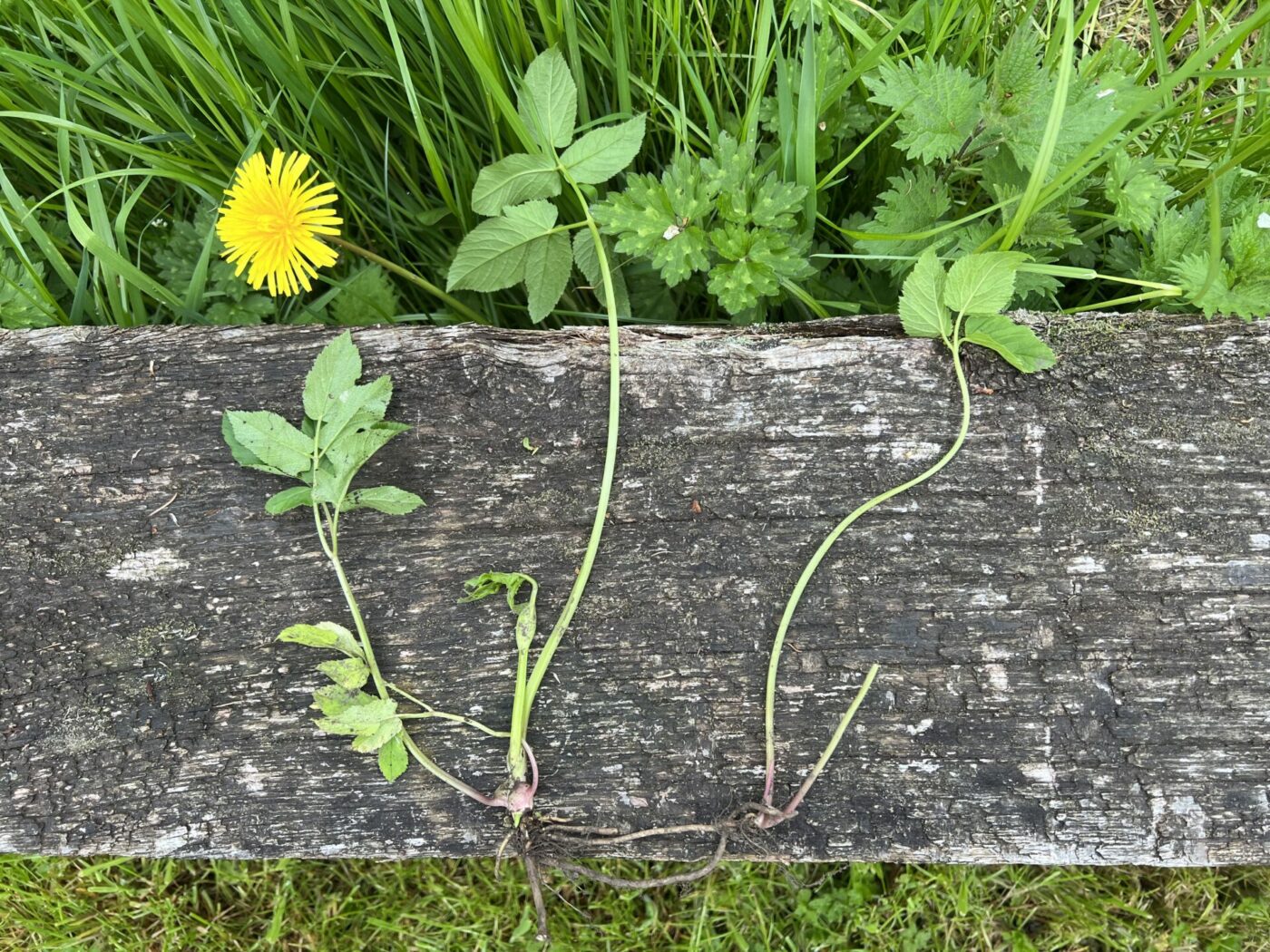
Unfortunately, ground elder spreads by underground rhizomes, horizontal roots with shoots, that spring up creating a dense mat that blocks out many plants of the same size. Eventually it will kill other perennials by taking light, water and nutrient, creating a monoculture of less value for wildlife and less interesting for us. It is a vigorous grower that will shoot from the tiniest bit of root and spreads rapidly.
Join my weekly newsletter for organic gardening tips
It grows between the roots of other plants making it hard to remove from between them. All in all, this is not a plant I would recommend in your garden, or the main bit of garden if you have a larger plot. If you love ground elder to bits, by all means grow it of course.
How I am tackling ground elder organically
| Technique | Result | Winner |
| Cover with cardboard and 5cm compost mulch | It did stop the plant growing through while the cardboard lasted. Cardboard and mulch is a technique only meant for use on annual unwanted seedlings however and as expected, it did not weaken the plant and as soon as the card decomposed by the following spring, the ground elder bounced back unscathed. | Ground elder 1, Jack 0 |
| Mowing through lawn | Where ground elder is growing in our lawn, mowing it weakened and killed patches of it over time. On the edge of the planting area containing the ground elder it did keep growing back into the lawn, but only made it about 30cm and never further in than this with regular mowing. Covering an area with lawn until it’s gone completely should work, after a number of years. | Ground elder 1 Jack 1 |
| Eat it | Lots of people have suggested eating ground elder into oblivion. I have tried eating its tender new shoots, it tastes quite nice as a salad crop. However anyone who’s tried dealing with ground elder will know, you’d have to be sat on the patch eating only ground elder for a number of years before your picking and munching truly made any kind of impact. | Ground elder 2, Jack 1 |
| Digging out | One sure fire way of getting rid of a plant in a patch of soil is to dig it out with all of its roots. Unfortunately, like bindweed and couch grass, ground elder roots are brittle, snapping easily. The plant can also grow from tiny bits of roots you can’t see with your eyes. However, the good news is that with some careful handling you can grip a piece of root in one hand and then with a hand fork in the other, trace it back getting rid of as much root as possible. In areas where I’ve done this, the plant is noticeably fewer in number with lower vigour when it grows back. With repeated digging out across each year, over a number of years, eventually it should all be gone. The challenge will be under existing shrubs, the hedge and a wall it grows under where its roots can hide, but I’m hoping to at least dig it back to these areas! | In progress |
| Loosen the soil | By digging out the ground elder I’m actually creating loose soil that makes it easier for the plant to grow in. Which sounds counterintuitive except loose soil also makes it easier to remove its brittle roots in future digging out sessions. In addition I have been recommended to cover areas with a thick layer of compost to encourage the plant to grow higher in this loose material to again make it easier to dig out. So I’m going to do both. | In progress |
| Tagetes minuta | Mexican marigold (an annual), Tagetes minuta, is said to kill ground elder using chemicals produced by its roots. This is called allelopathy and while it might sound too good to be true, it’s a genuine thing in plants, where some plants will release chemicals to suppress the growth of other plants. However, in my trial of Mexican marigold it had no impact whatsoever on the ground elder. I was skeptical this would work in one season anyway and I am happy to tell you that in my experience, the idea of Mexican marigold killing ground elder is a complete myth we can put to bed and forget. | Ground elder 3, Jack 1 |
| Suppressant matting | I’m going to cover some areas with suppressant matting to starve the plant of light. This will be like the cardboard but the matting won’t decompose, allowing it to stay put for a number of years hopefully killing the plant eventually. I have to admit I’ve tried this with couch grass and nettles and even after two years, the plants were alive and well! However, their roots were directly on the surface of the soil under the matting making it much easier to dig them out later and eliminate them. | In progress |
| Out compete it | One thing I know I can do quite easily is plant up the area with a number of plants that will outcompete and eventually kill the ground elder over the years with a slow decline in light, moisture and nutrients. Generally anything larger than the ground elder, that completely covers it. I’m not at this point because I want to see if the above methods can remove it to allow smaller plants back in. | not trying yet |
Update: 5 May 2022
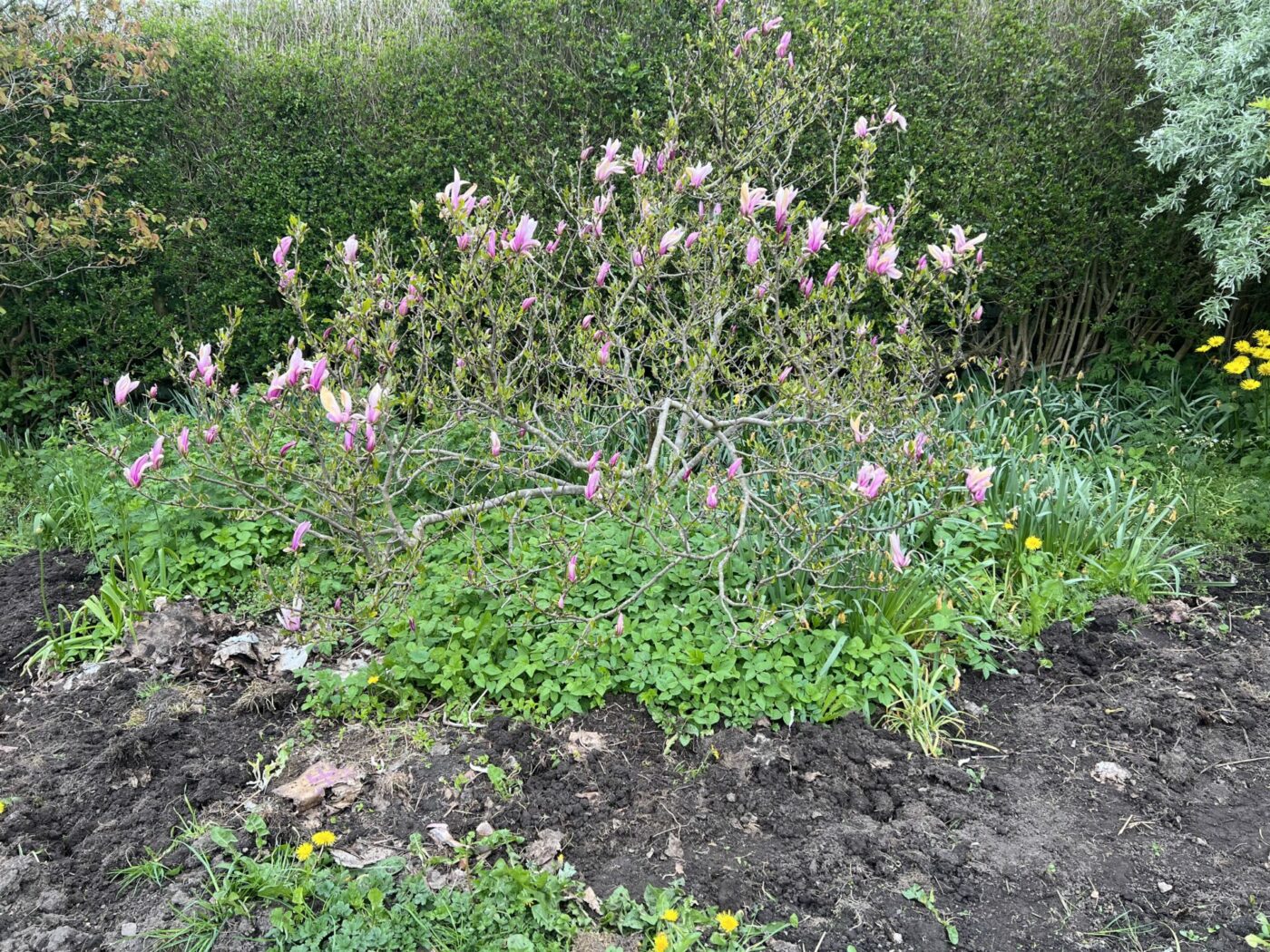
Above you can see our main patch of ground elder which sits largely beneath a shrub Magnolia and then runs under the hedge behind and under a dry stone wall behind that. I’ve begun by digging a metre around the outside of the patch, so I’ve already removed about 7 – 8 metres of roots in my first sweep of digging. It’s growing back but in lower quantities I can continue to dig. The challenge is how to get at it beneath the Magnolia and the hedge. Stay tuned.
Update: 16 September 2022
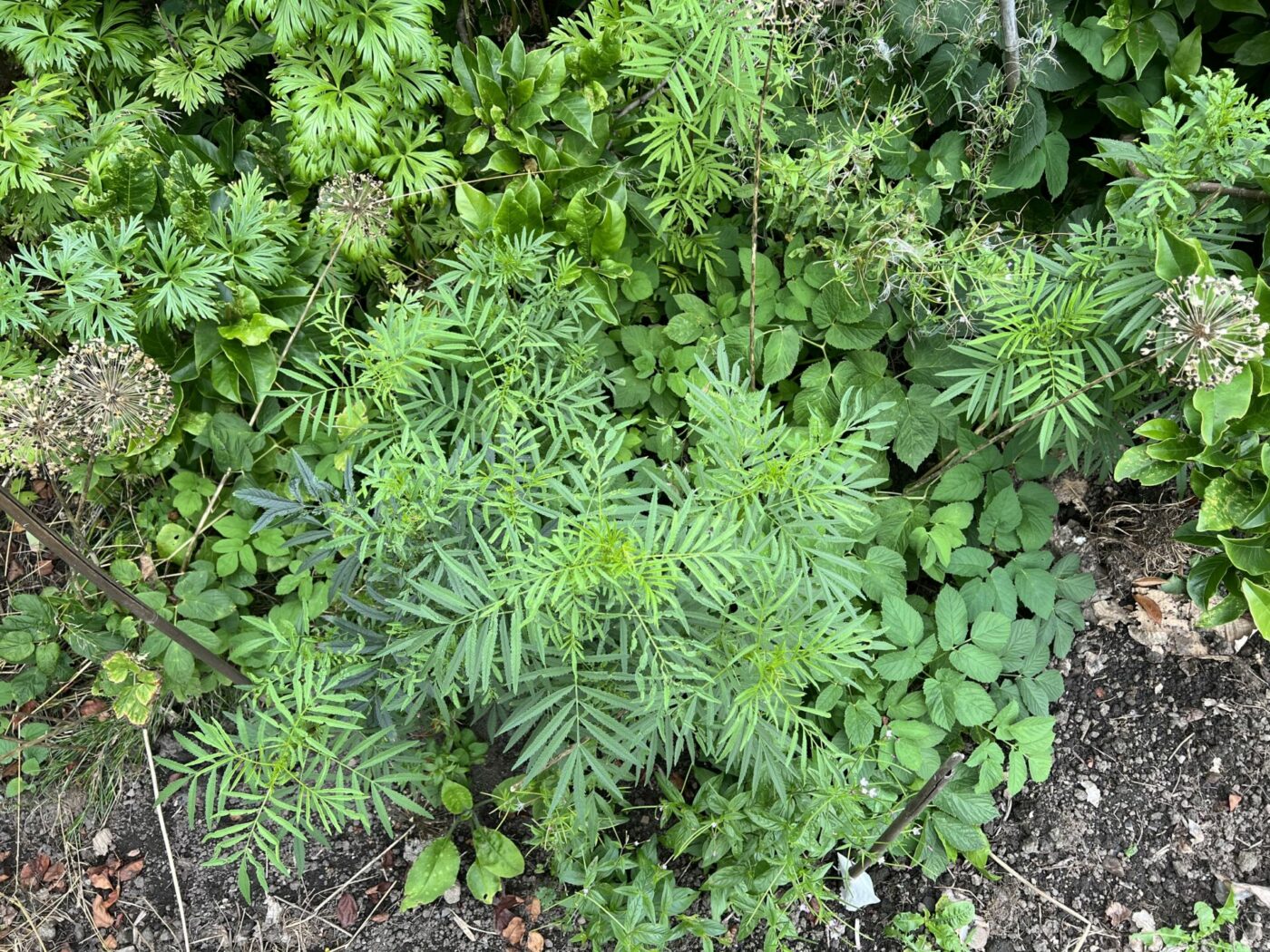
The size of the patch hasn’t seemed to really expand through summer, above ground at least! Hoeing off new shoots around the patch has so far appeared to work to contain it. The Tagetes minuta (Mexican marigold) has had no impact whatsoever. During very dry patches of summer the ground elder noticeably wilted before any other plant, suggesting it will struggle and potentially become less of a pain in future years. But watch out for other plants taking its place that love the drier conditions!
Update: 27 March 2023
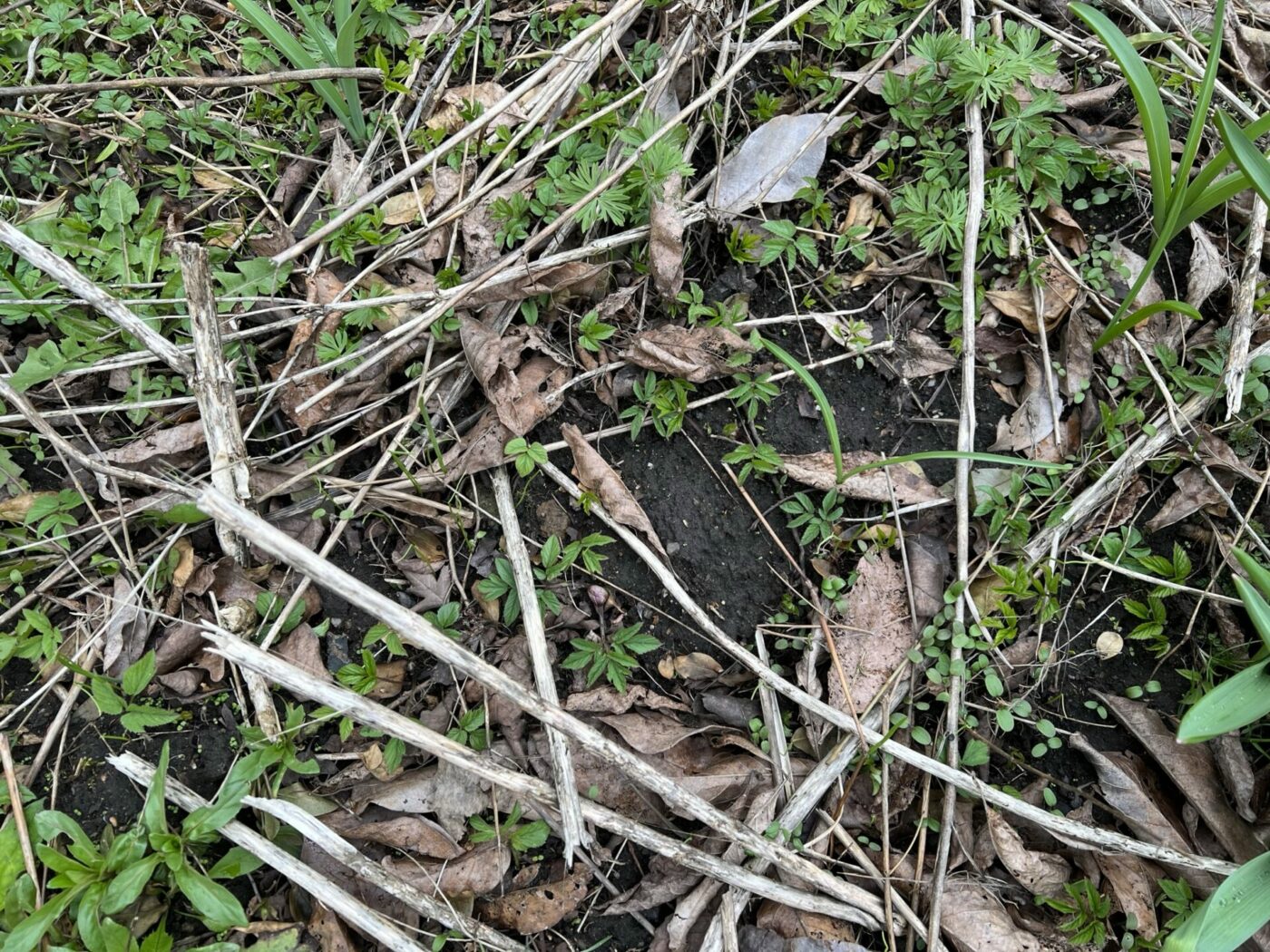
In the test patch of Tagetes minuta, shown in the photo above, the ground elder leaves is clearly seen coming back on mass as we enter spring the next year. If I were being generous I would say there is perhaps slightly less than the rest of the patch but there is still a lot. I would normally always like to try something at least twice before writing it off, but for now I think I will park Mexican marigold as a means of getting rid of ground elder unless someone can convince me otherwise. I am going to try other plants instead.
Update: 30 May 2023
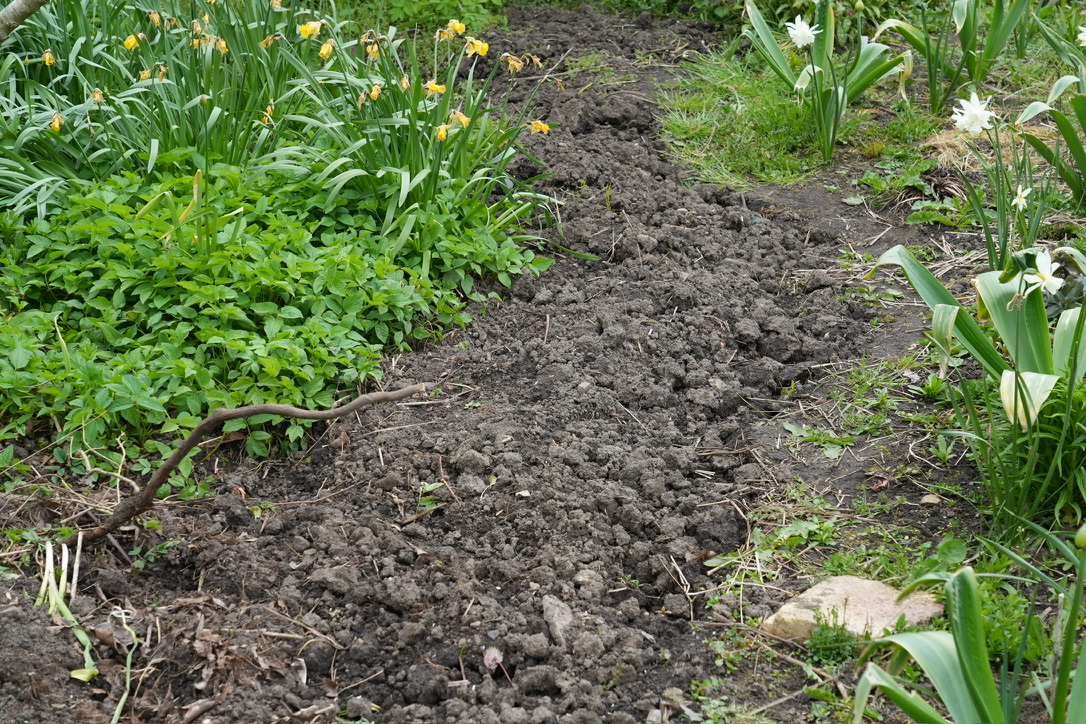
I’ve removed a couple of existing shrubs in the middle of the ground elder patch (and I suspect the source of the ground elder originally) giving me better access to the soil. This has made it incredibly easy to start from the outside of the ground elder patch and work back toward the hedge and wall behind it. I’m going to replace the old shrubs with new shrubs that have increased wildlife benefit once the area is clear. I doubt I’ll ever remove it completely from under the hedge and wall so my aim is to get it back to there, create an informal narrow path along the hedge for better access to cut the hedge that I can also use to patrol to keep the ground elder contained in the one spot, keeping the main border clear and ready to continue my wildlife planting. Once dug over, the ground is very loose and easy to then dig again, making repeated sweeps of ground elder as it emerges easier and easier. So far, this plan of digging and loosened soil is working well, though it is a lot of effort initially, especially removing large established shrubs. Note, normally I try to minimised digging as much as possible to not disturb soil life, however to get roots of problem plants out, this is the only way. I see the short term soil damage in this small spot is warranted by the long term gain of removing the diversity suppressing ground elder.
Update: 25 July 2023
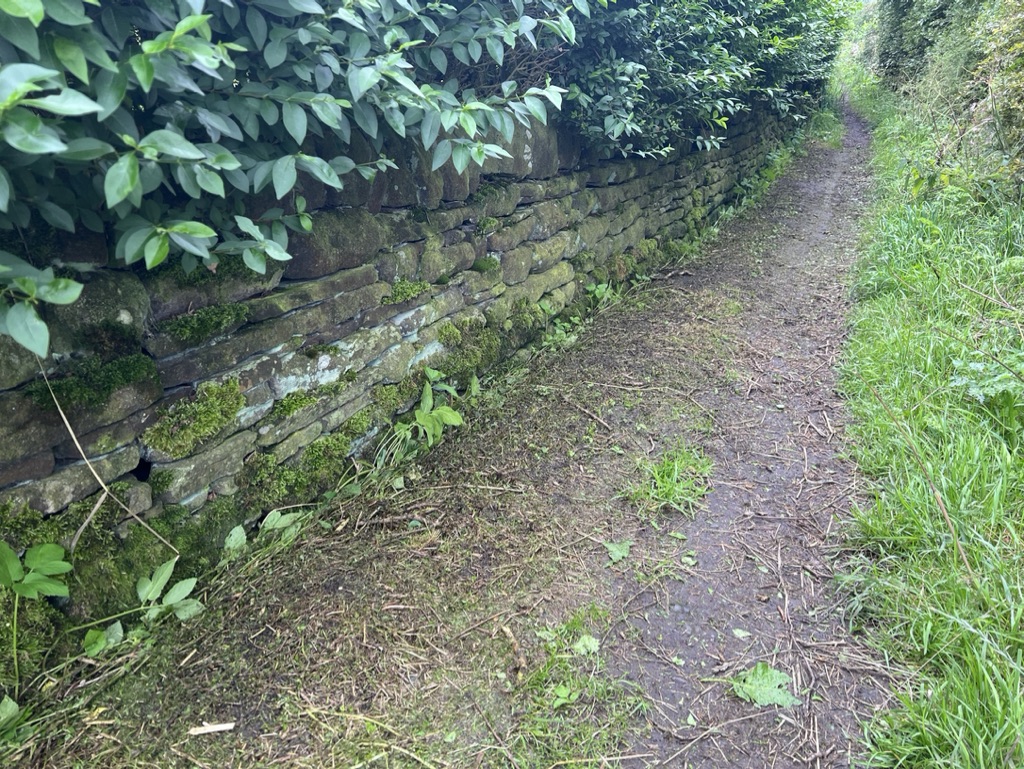
I have a really positive update to share, that the main area I’ve been digging out is now looking significantly clearer of ground elder. I’ve dug it out twice, with one or two more rounds of digging to do before winter. I think I will have reclaimed 1-2m of the planting area for next year, which is a big win! The challenge is around the boundary where we have a hedge and small stone wall (the outside of which is shown above). Here the ground elder is growing through the roots and under the wall, and out the other side. I was going to leave this but its spreading along the wall to almost 7 – 8m long, so I have begun mowing the ground elder on this side to weaken it. I have mowed it twice and will begin scattering seeds of grasses here to try and weaken it and reclaim that area for grass.
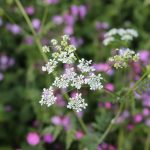

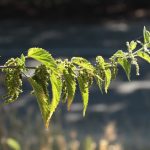
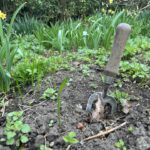
Will echinacea or goldenrod crowd out ground elder? Looking for an invasive pollinator that might do the trick.
I wouldn’t intentionally try planting anything that is considered invasive as this can harm wild ecosystems, and in some instances is illegal. Echinacea wouldn’t crowd out ground elder, golden rod might be thuggish enough to grow over it.
We’ve got a similar problem with Hypericum, I think it was originally planted under conifers, but now occupies a space about 20 m x 3 m. I think it’s going to be a very long project, but I think the tactic of starting one end and working back is a good one, and like you say, accepting, we will never get it out from underneath the conifers, but creating a strip that we keep free so it doesn’t invade again. Anyone got any better ideas?
Yes I think it’s the only way really, you can cover it with tarps for a few years but I just have this feeling it will take a lot of years to actually work!
Digging ours out with as much root as possible. Has to be done regularly to keep it down. Ours is in the rabbits ears/thyme/daisy and mint/lily of the valley. Originally came through the fence 😔 It’s a yearly fight.
Good to read, I’ve been waging war against the carpet of ground elder on the lot I got a year and a half ago and have gone for the tactic of covering bits I can’t bare to deal with yet and digging out areas as I can. Definitely been feeling like it is making a bit of a difference so I’ll endure!
My experience so far with ground elder removal is that it is fairly easy to make a difference by continuing to dig out and cover. And I’ve heard from other people who have had complete success by doing this. So I suspect the people who haven’t had success with removing ground elder may not have been quite as vigilant or have a particularly large garden.
Yes – dig dig dig! Over the years I’ve managed to eliminate large areas of ground elder. Extremely satisfying pulling gently on a long white / cream root to get it out of the soil intact. Now is an ideal time to start tackling it as the new growth is in soil that has been well watered by the rain, so relatively easy to dig. My best friend is my Hori-hori weeding tool. Long enough to get down around the roots. However be prepared to dig up any perennials ground elder has invaded, wash the roots really thoroughly to remove all traces of ground elder roots and replant in a pot for a year to check you’ve got it all.
Thanks for the tips Anne! It’s great to hear of these success stories to keep us all going. It’s certainly working here or us with repeated digging.
Hi from France ! I met with ground elder in the charming garden of my newly bought house.
I dug thoroughly some areas the first year (2022), had no access during spring the second year (2023) because of heavy renovation works. This year I can see that areas where I dug are way cleaner ! Yay ! I am highly motivated and digging ground elder is becoming my new hobby. Chasing those baby green leaves and pulling them gently is so satisfying haha. I extended the battle to the back of the garden but this area will be pretty tough.
Anyway, digging works. I can’t see any complete victory any time soon (the enemy has a solid rear base in the neighbor’s garden) but I feel the plant will stay manageable and I also plan to eat it.
Thank you for sharing your experience and spreading hope for us gardeners. May the green force be with you.
Claire
Thank you for sharing Claire! I am reassured more and more by other people who have had success from repeated digging out. It does seem to work and I think the key is to get into a routine every year to keep on top of it and eventually it can be contained. At least, that’s what I keep telling myself!
Jack
Thank you for the great research and information
Thanks Rob, it’s been an interesting challenge – despite having it, it’s been a good opportunity to share techniques with everyone.
I have been at war with ground elder since 2004. I am loosing. Never let it flower. Here is what didn’t work. I covered it with cardboard and plastic that didn’t work. It just grew through the tarp and around it. Vinegar and boiling water did not work at all. (used on side walk spaces). I resorted to roundup (North American weed killer) behind the garage. Also, it did not touch it. It was just the same as vinegar. The ground elder used to only be in the back, it has now moved to my front beds. We back on a green space and have lots of animals like bears, racoons, skunks, owls and squirrels. I cannot weed the green space. (wild protected park) Mowing seems to “work” for the lawn, but it still travels under ground between beds. I dig the roots up yearly in my garden beds which only lasts half a season. (our growing season lasts almost all year near Vancouver Canada, we are in a rain forest). The few times we get snow and frost and the tops die, but the roots grow faster and farther underground. I did not know, it was edible, I have not tried rabbits, but I think the owls and eagles will get them. Kidding, I will not introduce another invasive species. If the bears are eating it, they are not making a dent. One sleeps behind the kids tree fort in the back in the summer… maybe that’s why they like it there so much. I know they love to eat sea grass, maybe ground elder is why we have a bear every year. They hibernate half the year anyway, so not a solution. Thankyou for your fabulous web site. The enemy of your enemy is your friend. You sir, are my new best friend.
Haha thanks Lynette, in my plan of action I had never considered bears but perhaps I should! Although it’s taking ages to rewild the UK with beavers, so returning bears from extinction here may take a while! I think you’re right though, digging is the only real way and for that to work requires multiple digs per year.
Hi Jack,
Thanks for this article! I’ve been scouring the internet for trials on removing ground elder and have been amazed that there is a real dirth of good information, particularly comparing a few methods of removal. I am currently digging out ground elder from my border after recently moving into our new house, and think I will continue with the ‘dig out’ method to see if I can weaken the plants over time.
I look forward to your ongoing updates!
Lucy
Thanks Lucy, yes I found it hard to find reliable information I can trust prompting this article!
The good news is that I am finding that digging out does work and there are a number of people who confirm this. Which calls into the question the people who’ve told me ‘it just comes back’ which I believe weren’t relentless enough!
It is true that it will grow back easily but it’s not that fast, it’s still a plant that spreads by rhizomes. So if you keep digging out an area every few months through a growing season, it will have a big impact. I reckon I could remove it from a blank planting area in maybe 2-3 sessions over a year. Unfortunately, most gardens aren’t blank which makes it a longer process.
The key thing is to just keep repeating… please do keep us informed on how you get on too! Good luck
Jack
What a great article on the predicament that is ground elder. In my experience, digging thoroughly and/or consistently will at least keep it at bay. But it will always creep back in from hedges and bushes, where it seems impossible to get rid of it. It’s an everlasting battle, and it’s wearing me out, mentally if not physically.
So I’m trying a new strategy – a truce. I will let it stay in some parts of my garden as long as it stays out of my growing area (no-dig beds).
So far I’ve successfully removed it from the growing area when I established it, using “MyPex” style sheets for a whole year, growing potatoes through holes I cut in it, and then digging out what litle had survived of the ground elder this spring. (One patch needs another year of the same treatment though, it even has bindweed.)
To maintain the truce, I need a barrier all around the growing area. I will mainly use a trick I picked up from permaculturists and plant comfrey (Bocking #14) as a hedge. It is apparently the only hedge that ground elder can’t live under, or even creep through. But comfrey is very wide, so on some edges I’m going to trial another approach that doesn’t take up any space: to almost completely bury 6″ lawn edging of galvanised zinc (more lasting than steel, and cheap when bought as a roll). It will be interesting to see how well that works, if at all.
The ground elder itself I will have to mow, at least before it flowers, with a scythe (which is ridiculously easy). What I mow end up as compost. I actually think it’s not too bad looking as a ground cover, an edible one even. That I can live with, as long as it stays out of my no-dig beds.
I love these strategies! Yes, I think like you we are going to have to live with it under the boundary hedge and just somehow work out how to keep it in that spot.
Jack
Thank you for the information! I moved into a new home in August last year and the back garden was a sea of ground elder. There are lots of ferns as well. Under a amelanchiar and pear tree I tried cardboard and 6 inches of leaves. Seems to be peaking up in some spots. I dug out sections and placed cardboard and wood chips over, weakened it significantly. I’m going to try to solarize a patch. I’m also building raised veg beds (15 inches deep) of compost and delivered top soil with a layer of cardboard underneath. I hope it doesn’t make its way through that much mass.
Hi Whitney
My worry with cardboard, even thick layers is that it degrades fairly quickly and becomes soft when wet, so ground elder can work its way through. So it might be a case of continually topping it up, which should eventually work over a number of years. Where we are it is incredibly wet in winter and even thick layers of cardboard just don’t last for us unfortunately. Though it does work on weaker plants like grass and annuals. It will be interesting if you keep going to hear how it works for you.
Jack
We have ground elder growing under our conifers, so it’s a struggle to get under there to try and dig it out whilst being thorough, plus there is a pond next to it too. However, it’s not encrouching along the border where the flowers are that is shared with the conifers.
I may dig out as much as I can, then lay a heavy duty but permeable weed barrier under the conifer and lay a thick layer of woodchip over it to smother it, would that help suppress it under there?
Also, would it be an option to use a bamboo root barrier and bury it around a flower bed of interest that I don’t want succumbing to ground elder (leaving 2 inches of exposed barrier too…)? Or even placing the root barrier around the ground elder that’s under the conifers? trouble is I don’t want to miss-dig and cut through the rhizomes and place the barrier between the ground elder and it growing on each side!
Hi Josh,
Personally I don’t recommend using long term weed membrane barriers in that way, in my experience everything will just root and grow into the bark and through the membrane, eventually making it near impossible to then do anything! We have that out in our back garden where a previous owner has put down weed membrane and wild roses and dandelions just grow through it.
A bamboo root barrier would work yes, I don’t think ground elder goes particularly deep.
I always think these sorts of barriers and membranes are quick fixes that aren’t a one of hit long term, so I’m looking to plants to do the suppressing personally long term, but it’s still in an experiment stage so wouldn’t want to recommend a particular plant just yet. But as an example, ground elder cannot cope against the competition in a lawn, so something as dense as that would outcompete it.
Jack
My approach has been to dig rings of plastic barrels, large flower pots with bottoms removed etc into the garden, then remove all the soil from within and go through it with a fine toothed comb to remove all roots. I then replace the clean soil into the plastic ring. This leaves gaps between the rings which can be tackled at a later date. So far so good.
I’ve tried the barrier method with old carpets around gooseberry bushes. After about 20 years the carpet was still in tact but ground elder rhizomes are still present under it.
Unfortunately ground elder is also thriving under the hawthorn hedge. Any suggestions?
I’m interested in outcompeting the ground elder with other plants, it’s an ongoing experiment, but I believe this is where the future of dealing with it lies, especially under hedges.
I agree as my flower bed is beside a hedge and both invaded so I will work with it and would like planting suggestions to restrict growth by planting plants that can survive the competition! I’ve dug out nearly all plants, placed into pots for observation and then would like to plants long term plants. I was thinking also turning it into a vegetable bed with fennel, rhubarb rosemary, raspberry etc something I can let live but relax the weeding aspect!?!
I’m too old to spend the rest of my life chasing ground elder! The area is to be given over to chickens and I will just deal with what pops out from around the run! Nice plants are currently being dug up and kept in large pots. Other areas of the garden are GE free and I don’t want to risk introducing it with even a nanometre of root that I miss in the plants I want to keep.
I have been fighting ground elder wars for several years now and agree that the best way is to painstakingly dig it out. Membranes + woodchips are fine for a while but don’t last and putting in plants in holes in the membrane only encourages ground elder through where it becomes a nightmare in multi stemmed plants like hydrangeas, It will even go underneath paving slabs and pop up the other side. Lily of the valley will compete eventually if you help at first by taking out any bits of ground elder, geraniums will help until the summer when they go over and the weed pops out from underneath but my most successful competition by far is from Bergenia “Elephants Ears” which smothers it, You always have to be vigilant but this works for me , however I realise that it might not be everyone’s favourite and acknowledge that we do have a big garden.
What a wonderful site this is! I’ve moved to Wiltshire to a new garden with new challenges…stony clay soil and ground elder escaping from all sides of a very well installed gravel garden. I peeled back some fully intact membrane that is covered in a very thick layer of pebbles to gauge the extent of the challenge. Underneath there is a dense mat of thriving ground elder roots embedded in rock hard clay so I agree, covering up GE leads to more problems long term.
I replaced the exposed bit and started painstakingly digging out the roots that have spread through a whole border under a fence, through concrete, etc. It’s very hard work but satisfying. I think I might have given up but I feel hugely encouraged by all the tips and comments. Thank you!
Digging definitely works with persistence, and outgrowing it with other plants that will totally shade it too. But I’m still experimenting with that.
I loosen the soil up and let the chickens eat the roots. If the chickens are in the hen enclosure due to visiting Mr Fox I dig up chunks of soil containing roots and barrow the lot into their enclosure they just love it. I do try to remove worms etc. When the day is over the chicks have left soil free of roots and have added their own manure which doesn’t seem to contain any roots. Then I barrow back to the beds. Works a treat.
That’s a great tip thanks Nicola! Now I’m wondering if it’s worth putting a movable run over badly affected patches to let the chickens get to work!
We bought our house in 2012 and the whole garden, 120 square meters, was waist high ground elder. I dug, and dug, and dug for three years and gave up.
We literally dug up the whole garden aside from the brick shed, put down sand, weed tarp, sand, weed tarp, sand, and paved the whole garden.
We built three knee high raised beds, lots of planters, and are only now, 2025, removing the stones and sand.
We won. But it took years.